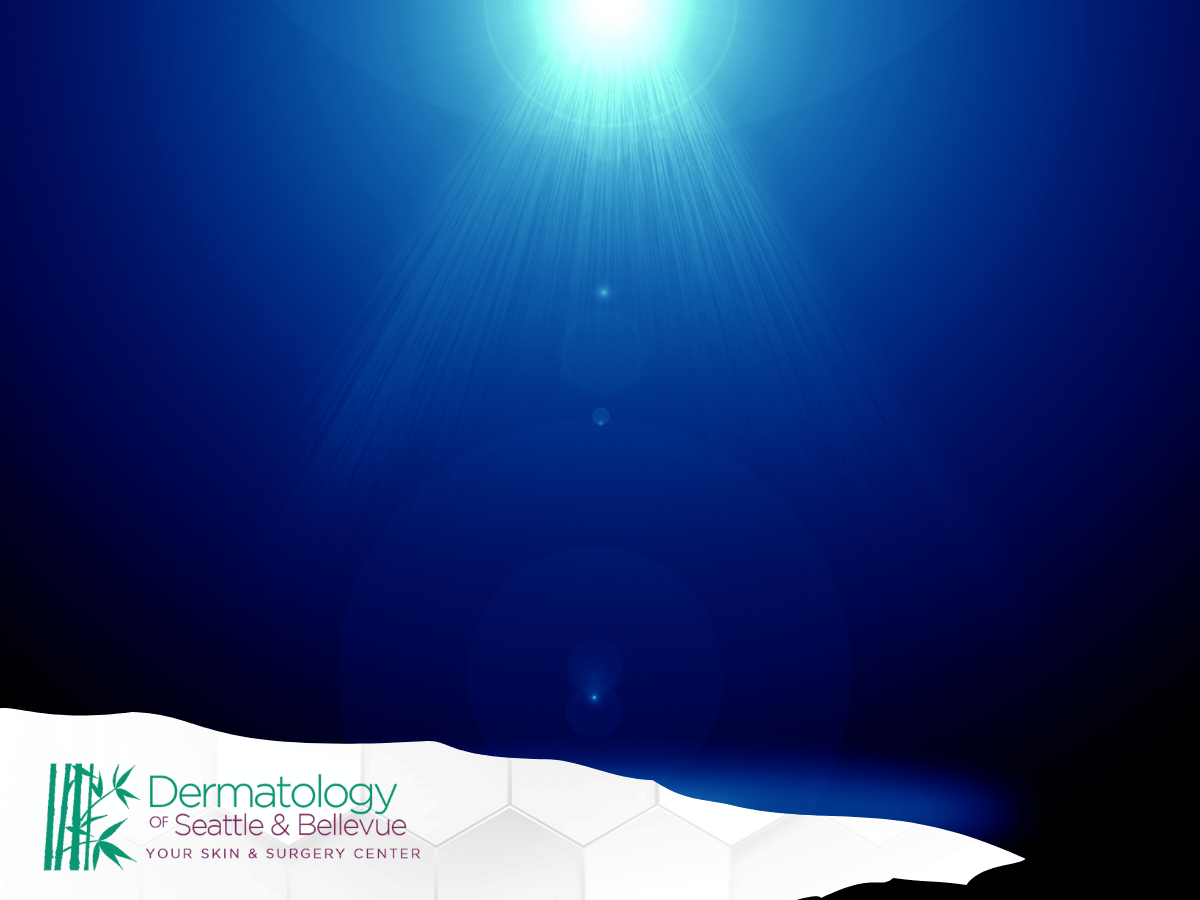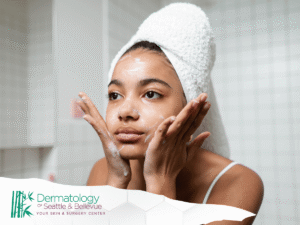Blue light isn’t just an eye strain culprit—it’s a growing skin health concern that many Seattleites overlook. With screen time on the rise and long, gray winters keeping most people indoors, understanding how blue light affects your skin can make a big difference in your long-term complexion health.
Dermatology experts in Bellevue and Seattle are increasingly warning about blue light’s role in premature skin aging and pigmentation. But don’t worry—once you understand what blue light is and how it impacts your skin, there are smart ways to protect yourself.
Understanding Blue Light
Before diving into its effects, it helps to know what blue light actually is and where it comes from. Many people associate it only with phones or computers, but its reach extends far beyond your devices.
What is Blue Light?
Blue light, also known as high-energy visible (HEV) light, is part of the visible light spectrum. It sits between ultraviolet (UV) and green light, meaning it carries enough energy to penetrate deep into the skin. Unlike UV rays, blue light exposure isn’t limited to sunlight—it’s constant, day and night, through screens and indoor lighting.
Dermatologists explain that while UV light causes immediate sunburn or DNA damage, blue light’s effects are more subtle and long-term, often leading to oxidative stress and premature aging.
Common Sources of Blue Light Exposure
Most Seattleites encounter blue light more often than they realize. The primary source is the sun, but everyday habits add to the exposure significantly. Screens from smartphones, computers, tablets, and TVs emit blue light in concentrated doses, especially when used for hours. LED and fluorescent lights—common in offices, homes, and even some skincare devices—also contribute.
Because of Seattle’s cloudy weather, people tend to spend more time indoors, which ironically increases blue light exposure from artificial sources. Over time, this consistent contact can take a toll on skin health if not managed properly.
Main blue light sources include:
- The sun (natural blue light)
- LED and fluorescent lighting
- Smartphones, tablets, and laptops
- Televisions and gaming monitors
The Effects of Blue Light on Skin
Now that you know where it comes from, it’s time to understand how blue light interacts with your skin. While it doesn’t cause sunburn like UV rays, research shows it can still penetrate deeply into the dermis—triggering inflammation, oxidative stress, and collagen breakdown. These effects may not appear overnight, but over time, they contribute to visible skin aging and uneven tone.
How Blue Light Contributes to Skin Aging
One of the main reasons dermatologists are concerned about blue light is its connection to accelerated aging. When HEV light penetrates the skin, it generates reactive oxygen species (ROS)—unstable molecules that damage cells and break down collagen and elastin. The result? Fine lines, dullness, and loss of firmness.
Blue light also contributes to hyperpigmentation, particularly in those with darker skin tones, by overstimulating melanin production. Since screen exposure often happens at close range, the damage tends to appear in concentrated areas like the cheeks and forehead.
The Role of Blue Light in Skin Damage
Beyond aging, blue light exposure can cause deeper biological changes within the skin. Continuous HEV light stimulates oxidative stress, which damages cellular DNA and weakens the skin’s natural repair mechanisms. This disruption leads to inflammation, dryness, and even sensitivity flare-ups in those prone to rosacea or eczema.
Some studies suggest that blue light may also impair the skin barrier—the layer responsible for locking in moisture and protecting against environmental aggressors. As that barrier weakens, skin becomes more vulnerable to irritation and dehydration, a common complaint among heavy device users in Bellevue’s tech-driven workforce.
Blue Light Protection Strategies
The good news? Protecting your skin from blue light is easier than you might think. A combination of skincare, smart screen use, and simple environmental adjustments can significantly lower your daily exposure. Dermatologists in Seattle recommend a layered approach that targets both prevention and repair.
Let’s explore practical strategies that fit seamlessly into your everyday routine.
Using a Blue Light Filter
Installing a blue light filter on your devices is one of the simplest and most effective ways to reduce exposure. Most smartphones, tablets, and computers now offer “night mode” or “eye comfort” settings that automatically shift the screen to warmer tones. This minimizes HEV light emission without compromising visibility.
You can also apply physical screen protectors designed with blue light filtering layers. For those working long hours in front of screens, blue light–blocking glasses offer an additional layer of defense—especially during late-night work sessions when exposure is highest.
Popular blue light filter options include:
- Built-in night or comfort modes on devices
- Anti-blue light screen protectors
- Blue light–blocking glasses
- Apps that adjust brightness and color temperature based on time of day
Essential Antioxidants for Skin Health
Antioxidants are the skin’s natural defense army against blue light–induced damage. They neutralize free radicals created by oxidative stress, helping preserve collagen and elasticity. Dermatologists often recommend incorporating antioxidant-rich products into your daily skincare routine, especially if you spend significant time in front of screens.
Vitamin C, niacinamide, and green tea extract are among the most effective ingredients for blue light protection. These not only help fight inflammation but also brighten dull skin and even out tone—a great bonus for those noticing pigmentation changes from frequent device use.
Top antioxidants that defend against blue light:
- Vitamin C (brightens and repairs)
- Niacinamide (strengthens the barrier)
- Vitamin E (nourishes and hydrates)
- Green tea extract (soothes irritation)
- Resveratrol (protects against environmental stressors)
Blue Light Skincare Products
Modern skincare science has evolved to tackle the challenges of digital exposure. From serums to moisturizers, many brands now include ingredients specifically formulated to protect against HEV light damage. Seattle-based patients often benefit from layering these products to build a full-spectrum defense—hydration, protection, and repair all in one routine.
Dermatologists emphasize that consistency is key: using a blue light–protective moisturizer or antioxidant serum every day can reduce visible signs of fatigue, pigmentation, and premature aging.
Recommended Products for Blue Light Protection
When shopping for blue light skincare, look for products labeled “HEV protection” or “digital defense.” These typically contain a blend of antioxidants, minerals, and botanical extracts designed to filter or absorb blue light before it can damage the skin.
If you’re unsure where to start, consulting a dermatologist can help tailor a regimen to your skin type and daily habits. Bellevue patients, for example, often benefit from lighter textures due to the city’s mild humidity, while Seattle residents may need extra hydration during the winter months.
Examples of effective product types include:
- Antioxidant serums with vitamin C or resveratrol
- Daily moisturizers formulated with blue light filters
- Sunscreens containing iron oxides (they reflect visible light)
- Overnight repair creams to restore skin barrier strength
Ingredients to Look for in Skincare
Choosing the right ingredients can make a world of difference when it comes to defending your skin from blue light exposure. Look for formulations that combine antioxidants, hydration boosters, and reflective minerals for a well-rounded shield.
Dermatologists often recommend products with iron oxides or zinc oxide, which help reflect visible light (including blue light) away from the skin. In addition, niacinamide strengthens the skin barrier, while lutein, a plant-based antioxidant, provides targeted defense against HEV light damage.
Beneficial ingredients for blue light protection:
- Iron oxides and zinc oxide
- Niacinamide
- Lutein
- Vitamin C
- Algae and botanical extracts (natural antioxidants)
Lifestyle Changes for Better Skin
While skincare products play an essential role, daily habits matter just as much. Reducing blue light exposure and supporting your skin’s natural recovery can be achieved with small, consistent adjustments to your lifestyle.
Seattle’s long workdays and screen-heavy routines make it especially important to balance digital time with mindful breaks, healthy nutrition, and restorative sleep. Let’s explore some practical habits that make a real difference.
Simple Daily Habits to Minimize Blue Light Exposure
Your skin—and your eyes—will thank you for taking simple steps to reduce blue light exposure throughout the day. It’s not about cutting out technology completely but rather about making small, sustainable changes.
Try keeping your phone on night mode after sunset, dimming your screen brightness, and maintaining a healthy distance from your monitor. It also helps to avoid scrolling in bed before sleep, as this disrupts melatonin production and affects both skin repair and rest quality.
Easy blue light–reducing habits:
- Enable “night shift” or “warm tone” modes on all devices
- Follow the 20-20-20 rule (every 20 minutes, look 20 feet away for 20 seconds)
- Use physical blue light filters or glasses
- Limit nighttime screen time for better sleep and skin recovery
Tips for Managing Screen Time
Blue light exposure is inevitable in a digital world, but managing it effectively can protect both your skin and your overall health. Start by setting screen time boundaries—schedule short breaks throughout the day and use apps that track and limit your device usage. Adjusting your workspace lighting to be softer and warmer can also reduce strain and minimize excess HEV exposure.
Incorporating screen-free activities like reading a printed book, walking outdoors, or practicing mindfulness before bed helps your body reset. Remember, your skin regenerates most effectively at night, so prioritizing digital downtime gives your complexion a real boost.
Smart screen-time management ideas:
- Schedule “no-screen” breaks every hour
- Use night or reading modes on devices
- Create a tech-free bedtime routine
- Adjust ambient lighting to reduce glare
Conclusion: Prioritizing Skin Health in a Blue Light World
As Seattle’s lifestyle becomes increasingly digital, understanding how blue light impacts your skin is essential for long-term skin health. From aging and pigmentation to barrier disruption, HEV light quietly affects the complexion more than most people realize.
The key is balance—combining practical habits like blue light filters and antioxidants with daily mindfulness around screen time. If you’re concerned about blue light damage or noticing changes in your skin’s tone or texture, consulting a dermatologist can help you create a personalized protection plan.
Dermatology of Seattle & Bellevue offers advanced skincare solutions and professional guidance to help you protect your skin from digital and environmental stressors—so you can stay glowing, confident, and protected in every light.
Disclaimer:
This information is for educational purposes only and should not replace professional medical advice. Always consult a qualified dermatologist for personalized skincare recommendations or concerns about blue light exposure.





